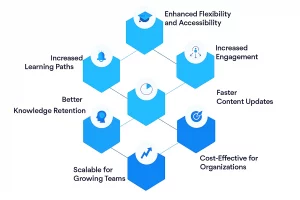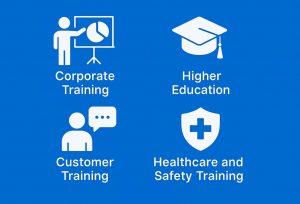In today’s rapidly changing learning landscape, traditional Learning Management Systems (LMS) are being challenged by a new approach, modular learning. As organizations look for more flexible, scalable, and personalized learning solutions, modular learning has emerged as a powerful model that transforms how employees, students, and teams acquire knowledge and skills.
This blog explores what modular learning is, its key features, benefits, and why it’s redefining how modern LMS platforms like Beetsol’s AI-powered LMS are built for the future.
What is Modular Learning?
Modular learning is an instructional design approach that breaks down a learning journey into smaller, self-contained units or “modules.” Each module focuses on a specific skill, concept, or objective that can be learned independently but also contributes to a larger learning goal.
Unlike traditional LMS models that deliver lengthy, linear courses, modular learning allows learners to:
- Access targeted content in smaller chunks
- Choose the sequence of learning based on their goals or job roles
- Progress at their own pace without being locked into rigid course structures
In simple terms, modular learning is like building with LEGO blocks, each block (module) stands on its own but can also connect with others to form a complete learning experience.
Key Features of Modular Learning
A modular LMS, such as Beetsol’s AI-driven LMS platform, is designed around flexibility, adaptability, and learner autonomy. Let’s look at the defining features that set it apart from traditional systems:
1. Microlearning-Based Design
Modular learning incorporates microlearning principles, delivering bite-sized lessons that are easy to absorb and retain. Learners can complete modules in minutes instead of hours, which keeps engagement high.
2. AI-Driven Personalization
Advanced modular systems use AI algorithms to recommend modules based on a learner’s behavior, progress, or skill gap. This ensures a personalized and data-driven learning journey.
3. Interoperable Learning Units
Each module is designed as a standalone unit that can be reused or combined with other modules. This interoperability makes it easier for organizations to create customized training paths for different departments or roles.
4. Scalability and Reusability
Modules can be updated, replaced, or scaled independently without affecting the entire course. This flexibility allows L&D teams to maintain content relevance effortlessly.
5. Assessment and Feedback Integration
Each module often includes built-in assessments and feedback mechanisms, allowing continuous evaluation of learner performance and understanding.
Benefits of Modular Learning

Organizations adopting modular learning within their LMS ecosystem are experiencing measurable improvements in engagement, performance, and ROI. Here are the major benefits:
1. Enhanced Flexibility and Accessibility
Learners can pick and choose modules that align with their learning goals or job roles, accessing them on-demand and across devices. This makes modular learning ideal for remote teams and global enterprises.
2. Increased Engagement
By presenting content in short, focused modules, learners avoid fatigue and information overload. The bite-sized approach promotes consistent engagement and better knowledge retention.
3. Personalized Learning Paths
With modular learning, employees can create their own learning paths based on individual needs, making the experience more relevant and motivating.
4. Faster Content Updates
Since each module is independent, content can be updated or replaced quickly without overhauling the entire course structure. This is especially useful for industries that evolve rapidly, such as technology or finance.
5. Better Knowledge Retention
Research shows that learners remember information better when it’s delivered in small, meaningful chunks. Modular learning helps reinforce learning through repetition and micro-assessments.
6. Cost-Effective for Organizations
Modular learning reduces content development time and cost. Modules can be reused across various training programs, saving resources and increasing ROI for corporate learning initiatives.
7. Scalable for Growing Teams
As organizations expand, new learners can quickly onboard through pre-built modules instead of lengthy onboarding programs, allowing faster scalability.
Why is Modular Learning Gaining Attention?
The shift toward modular learning is being driven by the need for agility, personalization, and measurable outcomes in learning environments. Several trends are fueling this change:
1. The Rise of AI and Data-Driven Learning
AI technologies are enabling LMS platforms to track learner behavior, performance, and engagement in real-time. Modular learning complements this by offering granular insights at the module level, allowing AI to recommend the most relevant content.
2. Evolving Workforce Demands
Today’s workforce demands continuous learning and career flexibility. Modular learning empowers employees to learn new skills without committing to long, rigid courses, fitting perfectly into the fast-paced digital workplace.
3. Shift Toward Skills-Based Learning
Organizations are moving from degree-based to skills-based training. Modular learning aligns seamlessly with this model by allowing companies to deliver targeted, skill-specific modules that can be tracked and measured.
4. Need for Agile Learning Solutions
Traditional LMS models often fail to keep up with rapid organizational changes. Modular learning provides the agility needed to roll out new training quickly and efficiently.
5. Learner-Centric Approach
Modern learners expect personalized, on-demand learning experiences similar to Netflix or Spotify recommendations. Modular learning fulfills this expectation by giving learners control over what, when, and how they learn.
Implementation of Modular Learning
Implementing modular learning within an organization involves a strategic shift in how learning content is created, delivered, and managed. Here’s how companies can transition effectively:
1. Define Learning Goals and Outcomes
Start by identifying what skills or competencies you want learners to gain. Each module should be aligned with a specific learning objective that supports these goals.
2. Break Down Existing Courses
If you already have traditional eLearning content, deconstruct it into smaller learning units. Each module should be a self-contained unit that delivers a clear takeaway.
3. Adopt an AI-Enabled LMS
An AI-powered LMS like Beetsol simplifies modular learning implementation by:
- Suggesting module combinations based on learner data
- Tracking performance across multiple learning paths
- Providing analytics for module effectiveness
4. Use a Content Library Approach
Create a centralized content library where all modules are stored, tagged, and categorized by skill, department, or role. This makes it easy to reuse and repurpose modules across learning programs.
5. Integrate Assessments and Feedback
Each module should include quizzes, simulations, or interactive elements for real-time feedback and evaluation.
6. Encourage Self-Paced Learning
Give learners autonomy to choose their learning path, complete modules at their own pace, and revisit topics when needed.
7. Measure, Analyze, and Optimize
Use data analytics to monitor completion rates, engagement, and knowledge retention. Continuously refine modules based on feedback and performance insights.
Examples of Modular Learning

Let’s look at how modular learning is being applied in real-world settings across different industries:
1. Corporate Training
Large organizations use modular learning to train employees on compliance, leadership, and soft skills. For example:
A company may have a “Leadership Development” course divided into modules like Emotional Intelligence, Decision-Making, and Team Motivation.
Learners can take each module independently based on their leadership maturity level.
2. Higher Education
Universities are adopting modular structures to allow students to earn micro-credentials or digital badges. For instance, completing multiple modules in “Data Analytics” could lead to a full certification.
3. Customer Training
SaaS companies use modular learning to onboard clients quickly, each module explains one product feature, allowing users to learn step-by-step without being overwhelmed.
4. Healthcare and Safety Training
Hospitals and industries with strict compliance requirements use modular training to update professionals on new regulations, ensuring consistency and fast updates.
5. Sales Enablement
Sales teams use modular learning to master different stages of the sales process, prospecting, negotiation, CRM usage, allowing targeted skill enhancement.
Applications of Modular Learning in Corporate Training
In the corporate world, modular learning has become a cornerstone of modern training strategies. Here’s how organizations are using it to drive performance:
1. Employee Onboarding
New hires can complete role-specific modules at their own pace, reducing the time and cost of onboarding while improving knowledge retention.
2. Compliance and Policy Training
Instead of lengthy annual sessions, compliance training can be delivered as short, trackable modules that employees can complete periodically.
3. Leadership and Soft Skills Development
Companies are building modular learning paths for leadership programs, focusing on communication, critical thinking, and emotional intelligence through short, interactive lessons.
4. Product and Process Training
Sales and support teams benefit from modular content that focuses on specific product features, helping them stay up-to-date with new releases and updates.
5. Reskilling and Upskilling
With AI-driven insights, companies can assign new modules to employees based on skill gaps or career goals, supporting a continuous learning culture.
The Future Belongs to Modular Learning
As learning demands become more dynamic, traditional LMS models are evolving into modular, AI-powered ecosystems. Modular learning isn’t just a trend—it’s a strategic transformation that aligns training with how people actually learn today: fast, focused, and flexible.
Platforms like Beetsol’s AI-native LMS are leading this change by making learning modular, intelligent, and measurable. Whether you’re building corporate training programs, onboarding employees, or driving professional growth, modular learning empowers your organization to stay ahead in a skills-driven world.
